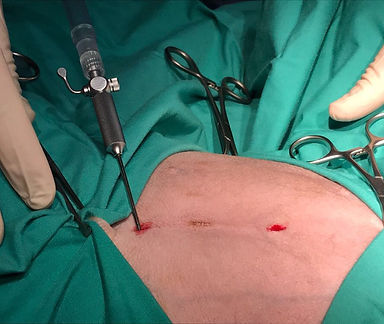
Why do we neuter dogs?
Neutering dogs increases their lifespan, this feels true to us as vets and is backed up by a huge (40,000 dog) study (Hoffman JL, 2013). It also prevents unwanted litters and the biannual rigmarole of managing a dog that is in season. That doesn't mean there are no downsides. Neutered females may be more likely to have issues like obesity or urinary incontinence and some forms of relatively rare cancer may be more likely to occur.
The health benefits for most dogs outweigh the drawbacks. Early neutering prevents mammary cancer in dogs and neutering at any time prevents womb infections, both of these conditions are prevalent (up to 25% of dogs by the of ten (Egenvall A, 2001)) and life threatening. It seems fairly settled opinion that neutering is advisable for female dogs but if you're not sure or would like more detail we are always happy to discuss.
What is keyhole neutering?
In traditional neutering the ovaries and uterus are removed via a midline incision, typically 5-10cm. In order to ligate (tie off) the ovaries and cervix they have to be pulled up through the incision and the organs surrounding dry out a little on contact with room air. These three factors all cause pain.
Basic Ovariohysterectomy


Keyhole neutering involves the introduction of a camera and instruments into the abdominal cavity via two 1cm incisions. The ovaries are visualised and ligated without the need for 'tugging'. The abdominal cavity remains sealed to room air.
Laparoscopic Ovariectomy


Why do we think it's better?
Less Pain
It is intuitive that if you make a smaller incision there will be less pain. In reality most experienced surgeons make quite small incisions for routine ovariohysterectomy already. Whilst the aesthetic result of keyhole neutering tends to be superior to basic spaying most of the advantages derive from what you can't see. All vets will tell you the most painful part of a basic spay is when the surgeon has to pull the ovary through the abdominal incision. This often results in hyperventilation of the patient and requires an increase in anaesthetic dose. In keyhole procedures this is not necessary. Dogs undergoing keyhole neutering have lower pain scores and increased post op actvity. (Culp WT, 2009; Hancock RB, 2005; Gower S, 2008.)
Fewer Complications
Small incisions and accurate haemostasis means patients undergoing keyhole surgery typically lose less blood than those undergoing basic ovariohyserectomy. They also have a lower risk of post operative adhesions (Shariati E, 2014.) In our experience they have lower rates of infection or seroma formation.
Quicker Recovery
Dogs recover quicker from keyhole surgery because it's less painful. This means they need fewer drugs and feel more like themselves sooner. The incisions are smaller and this means they can return to exercise sooner, this stops them being bored and bothering their incision. (Gower S, 2008; Culp WT, 2009.)
References
Culp WT, Mayhew PD, Brown DC. The effect of laparoscopic versus open ovariectomy on postsurgical activity in small dogs. Vet Surg. 2009 Oct;38(7):811-7
Devitt CM1, Cox RE, Hailey JJ.Duration, complications, stress, and pain of open ovariohysterectomy versus a simple method of laparoscopic-assisted ovariohysterectomy in dogs. J Am Vet Med Assoc. 2005 Sep 15;227(6):921-7.
Egenvall A1, Hagman R, Bonnett BN, Hedhammar A, Olson P, Lagerstedt AS. Breed risk of pyometra in insured dogs in Sweden. J Vet Intern Med. 2001 Nov-Dec;15(6):530-8.
Gower S1, Mayhew P. Canine laparoscopic and laparoscopic-assisted ovariohysterectomy and ovariectomy. Compend Contin Educ Vet. 2008 Aug;30(8):430-2, 434, 436, 438, 440.
Hancock RB1, Lanz OI, Waldron DR, Duncan RB, Broadstone RV, Hendrix PK.Compar ison of postoperative pain after ovariohysterectomy by harmonic scalpel-assisted laparoscopy compared with median celiotomy and ligation in dogs. Vet Surg. 2005 May-Jun;34(3):273-82
Hoffman JM, Creevy KE, Promislow DEL (2013) Reproductive Capability Is Associated with Lifespan and Cause of Death in Companion Dogs. PLoS ONE 8(4): e61082. doi:10.1371/journal.pone.0061082
Shariati, E., Bakhtiari, J., Khalaj, A., & Niasari-Naslaji, A. (2014). Comparison between two portal laparoscopy and open surgery for ovariectomy in dogs. Veterinary Research Forum : An International Quarterly Journal, 5(3), 219–223.



